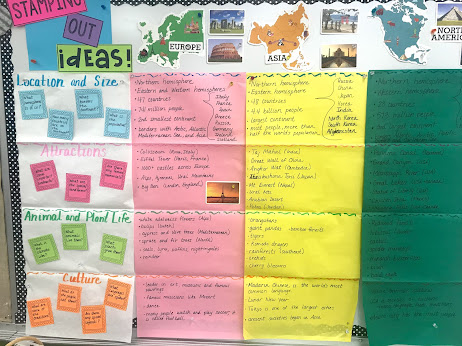These third graders are ROCKING the October RAZ Reading Challenge. I am so proud of how hard they are working to make the 300 minute home reading goal. More than half the students have already met the goal and I just love that they are still going! Our reading leaders (jarls) change almost daily. The students are just minutes apart, it is fun to see them using the competition to lift each other up! Reading is ALL!
Saturday, October 24, 2020
Reading is ALL!
Franken-Friday!
Friday was all about Frankenstein! We celebrated with silly poems, great stories, fun drawings, and freaky math games! We started the day with a video/story of Frankenstein (kid appropriate). We used the story to discuss the physical and personality traits of this famous monster.
Then we practiced writing a RADD response to the question "What is an important personality trait of Frankenstein?" The RADD writing response is a way to organize children's thinking and effectively and completely answer questions about text. This is a test taking strategy for short answer and essay questions. RADD stands for restate, answer, detail, detail. Together we wrote a very complete answer using evidence from the story to support our thinking.
Like Dr. Frankenstein combined parts to make his monster. We practiced using coordinating conjunctions to combine simple sentences into compound sentences. This is a third grade standard. See if your child can name the FANBOYS, coordinating conjunctions.
Next we learned a silly song/poem about Frankenstein to put in our fluency binders. We did a guided drawing to put with the poem. The students loved drawing him so much, many students made another drawing to put in their SeeSaw journal. Check them out!
We read a fractured tale of Frankenstein called Porkenstein. The children LOVED it! It is such a joy to share a story with students and listen to their giggles and squeals of delight. Then, we wrote our own fractured tales with Frankenstein. We have ben working with narratives this month. In narrative writing, the story needs a beginning, middle, and end. We made trifold Frankenstein stories so that the students could really focus on the parts of a narrative. Students chose their Frankenstein adventure. They could write what would happen if Frankenstein game to school, if Frankenstein came to dinner, went trick or treating with them, or played on their sports team. The stories were very entertaining.
In math, we had a Frankenstein relay. Students had to walk like Frank, fill in a missing number on the number "scars" and send up another team member. The number line scars skip counted by 10s but started at numbers that were not multiples of ten. For example, 112, 122, 132, 142, etc. We continued working with number scars by illustrating what a multi digit subtraction problem might look like on a number line. It was messy math....but a lot of excellent thinking. Happy Franken-Friday!
Typing Club
Friday, October 2, 2020
Amazing Artists
This week we did an art lesson that coupled with a wonderful story about Vincent Van Gogh. The book is called Camille's Sunflowers. The book describes Vincent Van Gogh's time in a French village where he becomes friends with a family that lives next door to him. It was during this period of his life that Van Gogh painted his famous sunflowers. We used the text to analyze narratives. After reading, we not only sequenced the plot events, we also sorted the events by important and less important. We also read a book in RAZ kids about the famous artist's time in France. We learned so much!

Then, the students' favorite part! They drew and painted their own sunflowers. The students used oil pastels and a watercolor wash to create these amazing works of art. They are so proud of their creations.




Stormy Skies
Our first third grade science unit explores weather and climate in a unit called "Stormy Skies." We started the unit by studying clouds. We explored how clouds form. We even used hot water and lidded cups to make a gas trap. Then, we made a book about the different types of clouds and how to spot a storm cloud. We had several scenario cards with where the students studied the clouds and wind and had to decide if a storm was on the way. The science discussions were rich.

For the next part of the unit, we studied geography, climate, and global weather patterns. First, the students made a climate decoder that had the average winter and summer temperature from different cities around the word. They transferred the information from the climate decoder to a map of the world. At the end, the students could see the different climate zones: tropical, polar, temperate, mild, and desert. We discussed what animals and plant live in the different zones and how they adapt to the climate.

The very last section of the stormy skies unit was a STEM challenge (science, technology, engineering, and mathematics). The challenge was to build a house that could withstand a wind storm. Students experienced the design process. They did a great job at coming up with an idea, testing it, and making adjustments.


Around the World Inquiry
Our first inquiry project this year combined reading, social studies, and science with an “Around the World” theme. We used our research skills to explore and write facts about all seven continents. Before getting stamps in our passports, we had to stamp out our inquiry ideas. As a class, we brainstormed questions to research about the continents. The students had awesome questions. They asked things like:












































